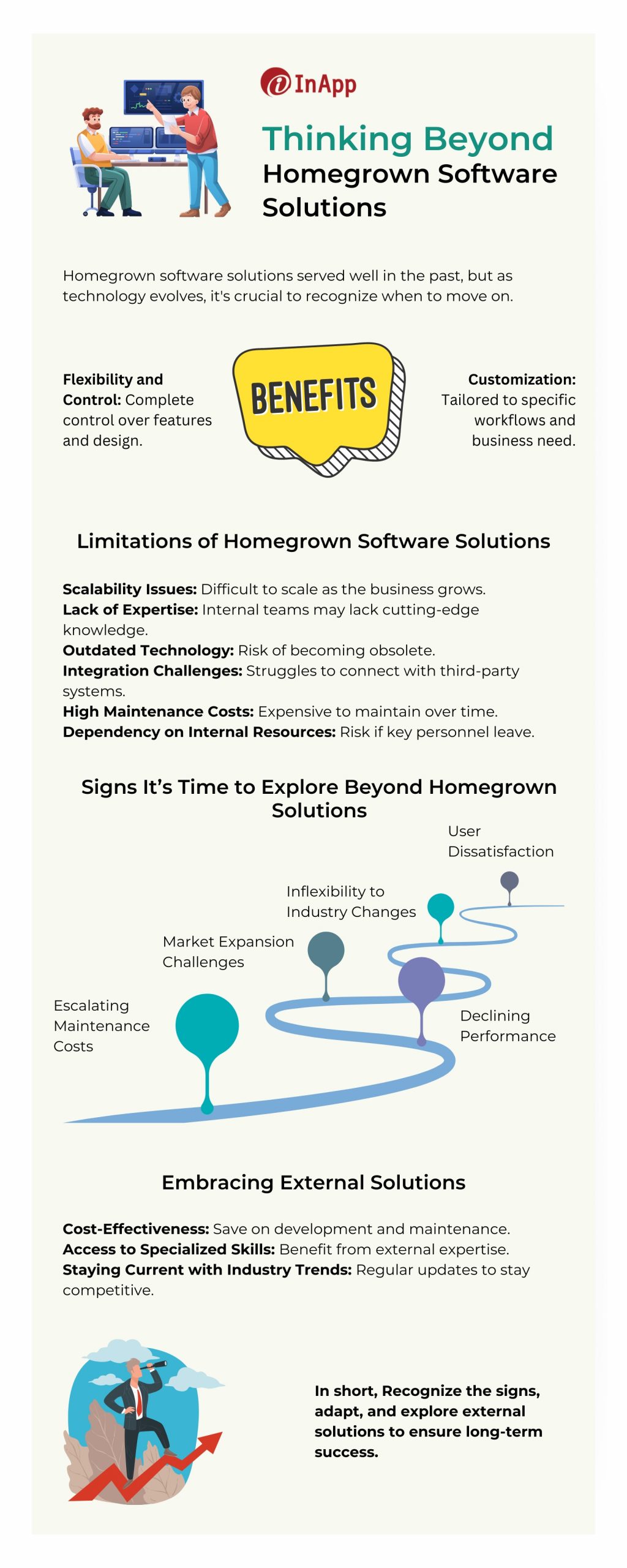Homegrown software solutions have long been the cornerstone for organizations seeking to digitize their operations. Initially crafted to address specific needs, these bespoke solutions played a vital role in the early stages of technological advancement.
However, evolving businesses face limitations in adaptability and scalability, with homegrown systems seeing a decrease in market share from 5% in 2014 to 2% in 2022. Homegrown solutions, once the pinnacle of customization, now face limitations in adaptability and scalability crucial for contemporary growth.
This blog explores when and why organizations need to consider external solutions instead of relying solely on in-house software.
What are Homegrown Software Solutions?
Homegrown software solutions are custom-made apps created in-house for specific needs. Unlike off-the-shelf software, they offer high customization and control. For example, a retail company might have its own Point of Sale (POS) system. It’s tailored to fit the company’s workflows, giving a competitive edge.
While homegrown solutions offer customization, they may face challenges such as scalability issues and a potential lack of expertise in emerging technologies, prompting organizations to consider external alternatives for long-term adaptability and growth.
Homegrown solutions are popular because organizations can control software features. They like the flexibility to design apps that meet exact needs and boost efficiency. In-house development fosters ownership and quick adjustments for changing business needs.
Yet, tech complexity and the need for easy scalability are changing trends. Organizations see limits in homegrown solutions adapting to new tech and rapid growth. This realization makes them look at external options providing customization and specialized expertise. It ensures success in a constantly changing digital world.

What are the limitations of Homegrown Software Solutions?
Homegrown software solutions, while offering tailored advantages, come with limitations that organizations must consider when relying solely on in-house developed software.
1. Scalability Issues
One of the primary limitations is scalability. Homegrown solutions are often designed to cater to specific current needs, and adapting them for growth can be challenging. As businesses expand, the software may struggle to accommodate increased data, users, or functionalities. This lack of scalability can impede the organization’s ability to respond to the evolving demands of a growing enterprise.
2. Lack of Expertise
In-house development teams may possess expertise in the organization’s core activities, but they might lack specialized knowledge in emerging technologies or industry best practices. As technology evolves at a rapid pace, homegrown solutions may fall behind in terms of incorporating the latest advancements. This limitation can hinder the software’s ability to leverage cutting-edge features and may result in a competitive disadvantage.
3. Potential for Outdated Technology
Homegrown software solutions may be susceptible to using outdated technologies. Maintaining and updating the software to stay current with the latest security protocols, compliance standards, and technological trends can be resource-intensive. Without a dedicated focus on staying up-to-date, the software may become vulnerable to security risks and compatibility issues.
4. Integration Challenges
Homegrown software solutions may face difficulties when it comes to integrating with other third-party systems or applications. As businesses adopt diverse tools and technologies, ensuring seamless connectivity between in-house software and external solutions can become complex. Integration challenges can hinder workflow efficiency and data exchange, limiting the overall effectiveness of the homegrown system.
5. High Maintenance Costs
While homegrown solutions provide a level of customization, maintaining and supporting them over time can incur high costs. Organizations may need to allocate significant resources for ongoing updates, bug fixes, and user support. The financial burden associated with continuous maintenance can outweigh the initial benefits of in-house development, especially compared to the potentially cost-effective and regularly updated options available in the external software market.
6. Dependency on Internal Resources
Homegrown software solutions often rely heavily on internal resources, including development teams and IT staff. In the event of staff turnover, skill gaps, or competing priorities within the organization, software development and maintenance continuity may be at risk. Dependency on internal resources can lead to delays in addressing issues, implementing updates, or adapting the software to changing business requirements, impacting overall operational efficiency.
Signs it’s time to explore beyond homegrown solutions
While homegrown solutions may have served your requirements initially, there comes a point where their limitations become apparent. Recognizing these signs is crucial for ensuring continued efficiency and growth.
Here are six key indicators that signal it’s time to explore beyond homegrown solutions. From escalating maintenance costs to declining performance and market expansion challenges, these signs act as valuable prompts for organizations to assess and evolve their software strategies for sustained success in an ever-evolving digital landscape.
1. Escalating Maintenance Costs
If your organization is experiencing a notable increase in the costs associated with maintaining and updating your homegrown software, it may be a sign that the solution is becoming inefficient. Rising maintenance expenses can indicate a need to explore alternatives that offer cost-effective and sustainable long-term solutions.
2. Declining Performance
A noticeable decline in the performance of your software, characterized by slower response times, increased system errors, or inadequate scalability, signals a potential limitation in your current solution. This dip in performance can hinder overall productivity and user satisfaction, prompting a reevaluation of whether an external solution can better meet your organization’s growing needs.
3. Market Expansion Challenges
If your business is facing difficulties expanding into new markets or accommodating evolving industry demands due to limitations in your homegrown software, it’s a clear signal to explore beyond. External solutions often provide the scalability and adaptability required to seamlessly integrate with diverse market requirements, enabling smoother business expansion.
4. Inflexibility to Industry Changes
The inability of your homegrown solution to swiftly adapt to industry changes, regulatory updates, or emerging technologies can impede your organization’s agility. External solutions are often designed to stay current with industry trends, ensuring that your software remains aligned with the dynamic landscape of your business environment.
5. User Dissatisfaction
Increasing user dissatisfaction, expressed through feedback on usability issues, lack of essential features, or dissatisfaction with the overall user experience, can be a crucial indicator. External solutions, with their focus on user-centric design and continuous improvement, may offer a more satisfying experience for both internal users and external customers.
Regularly assessing these signs and being proactive in identifying areas where homegrown solutions may fall short can guide organizations toward making informed decisions about exploring external alternatives for sustained growth and efficiency.
Embracing External Solutions
As your organization evolves, embracing external solutions becomes imperative when homegrown systems show signs of strain. Outsourcing or adopting third-party solutions offers a myriad of advantages, and this section explores the transformative benefits.
1. Cost-Effectiveness
External solutions often prove more cost-effective, eliminating the need for extensive in-house development, ongoing maintenance expenses, and infrastructure costs. This allows organizations to allocate resources strategically and maximize the return on investment.
2. Access to Specialized Skills
External providers bring a wealth of specialized skills and expertise that might be lacking in an in-house team. Access to a diverse talent pool ensures that your software benefits from the latest industry insights, cutting-edge technologies, and best practices.
3. Staying Current with Industry Trends
In a rapidly evolving technological landscape, staying current with industry trends is essential. External solutions are continuously updated to incorporate the latest advancements, ensuring your software remains competitive and aligned with the dynamic needs of your industry.
As organizations embrace external solutions over homegrown systems, the decision between building a custom software solution and purchasing an off-the-shelf alternative is pivotal. While off-the-shelf solutions offer convenience, custom software aligns precisely with unique business needs, fostering innovation and competitive advantage. Here is a detailed article on the benefits of custom software development over off-the-shelf software.
Choosing a tailored solution ensures scalability, flexibility, and lasting relevance in tech changes. Deciding between custom and off-the-shelf solutions is a strategic investment. It shapes a tech infrastructure that meets immediate needs and positions the organization for long-term success and resilience in a dynamic business environment.
Adapt or Lag: The Imperative of Growth
Recognizing the opportune moment to move beyond homegrown software solutions is pivotal for businesses seeking growth and adaptability. As the technological landscape evolves, the limitations of in-house solutions become apparent, necessitating a shift towards external alternatives. Organizations must evaluate their current software strategies with a keen eye on scalability, expertise, and staying current.
Embracing external solutions is not just a response to challenges; it’s a proactive step towards sustained success. By choosing the right time to explore beyond homegrown solutions, businesses position themselves to navigate the complexities of an ever-changing market, ensuring efficiency, innovation, and long-term resilience.
Frequently Asked Questions
What are the signs that indicate it’s time for an organization to explore custom software solutions?
Inefficiencies in existing systems, difficulty in scaling current software, frequent manual workarounds, and a need for unique features not provided by off-the-shelf software are some signs that it’s time to explore custom software solutions. If your business struggles with these issues, investing in custom software can enhance efficiency, scalability, and tailor-made functionalities to align with specific organizational requirements.
How do custom software solutions contribute to cost-effectiveness in comparison to homegrown software?
Custom software is cost-effective compared to homegrown solutions as it offers tailored features without in-house complexities. Custom solutions are built by expert teams, reducing development time and ensuring efficient coding. They eliminate the need for internal hiring, training, and infrastructure costs associated with homegrown development. Apart from these, custom solutions can scale resource usage based on project needs, preventing unnecessary expenses.
What risks are associated with not keeping homegrown software solutions up-to-date with industry trends?
Failing to keep homegrown software updated with industry trends poses significant risks. Outdated solutions may lack essential features, compromise security, and hinder overall efficiency. These risks can result in increased operational costs, diminished competitiveness, and potential vulnerabilities to security threats. Choosing modern, industry-aligned solutions ensures ongoing optimization, security, and competitiveness, contributing to long-term cost-effectiveness and sustained success.
Can custom software solutions be customized to meet specific business needs?
Yes, custom software solutions are inherently designed to be tailored to specific business needs. Unlike off-the-shelf software, custom solutions are created from scratch, allowing businesses to dictate features, functionality, and user experience. This customization ensures that the software aligns precisely with the unique requirements, processes, and objectives of a particular business.
How can organizations ensure a smooth transition from homegrown to custom software solutions?
Achieving a smooth transition from homegrown to custom software solutions involves a strategic and collaborative approach. Begin with a comprehensive analysis of existing processes and requirements, engaging stakeholders to define clear objectives. Employ an experienced development team to design and implement the custom solution, prioritizing scalability and flexibility. Implement effective change management strategies to ease the transition for end-users. Rigorous testing and phased implementation help mitigate risks. Regular communication, training sessions, and ongoing support ensure user adaptation and guarantee the continued success of the custom software integration.
What are the key considerations in deciding between custom and off-the-shelf software solutions?
Choosing between custom and off-the-shelf software hinges on specific needs, budget, and scalability. Custom software offers tailored features but requires more time and expense. It suits unique requirements and ensures a perfect fit. Off-the-shelf solutions are quicker and more cost-effective but might lack full customization. They’re suitable for common needs with established functionalities.
Consider factors like project complexity, long-term goals, and the need for ongoing support when deciding between the two, aiming for a solution that aligns with immediate requirements while accommodating future growth.
What role does innovation play in the choice between homegrown and custom software solutions?
Custom solutions, often developed externally, leverage innovation to address specific business needs efficiently. These solutions tap into the latest technologies, benefit from diverse expertise, and adapt swiftly to market trends. On the other hand, homegrown solutions, created in-house, demand a robust innovation culture within the organization.
